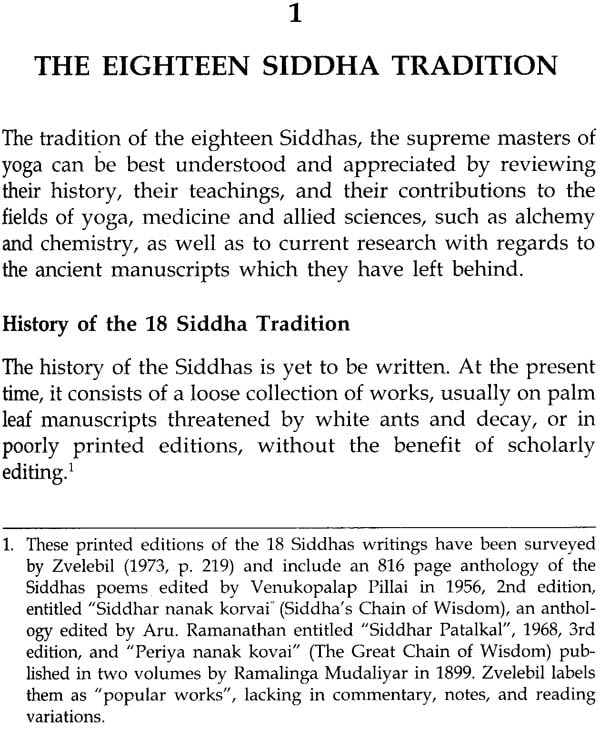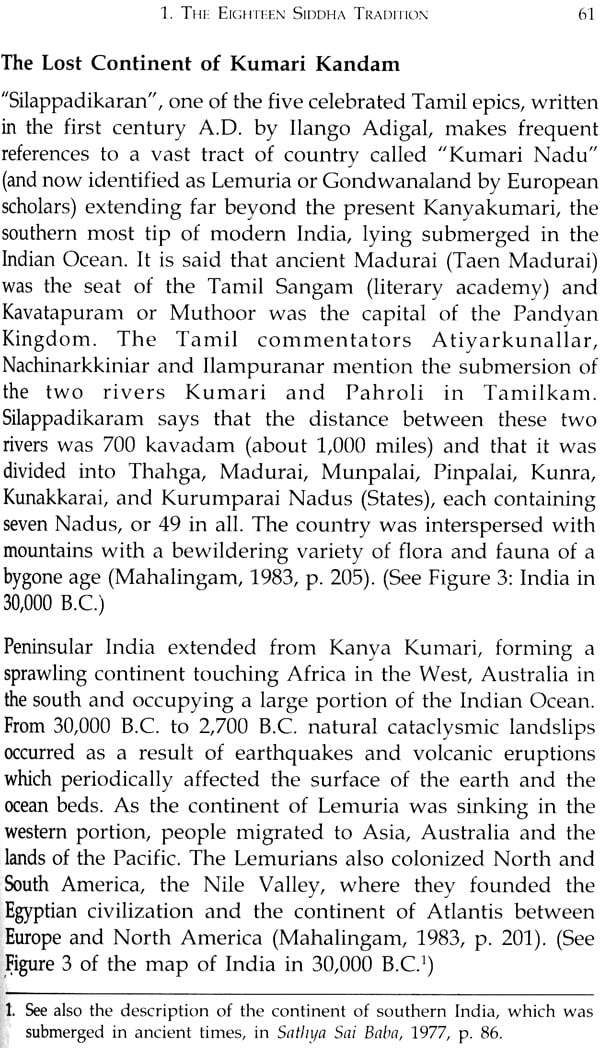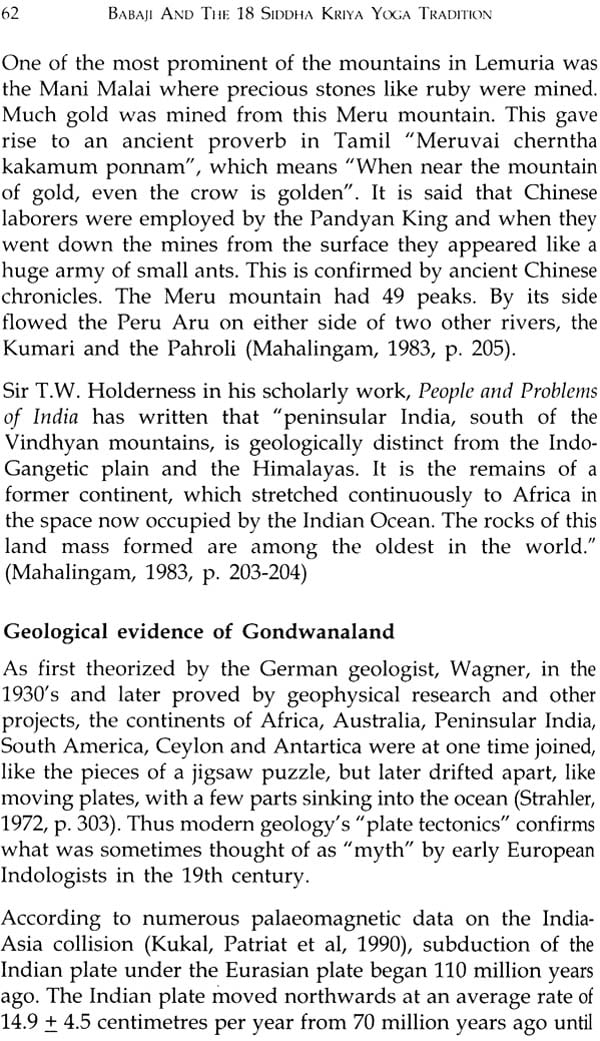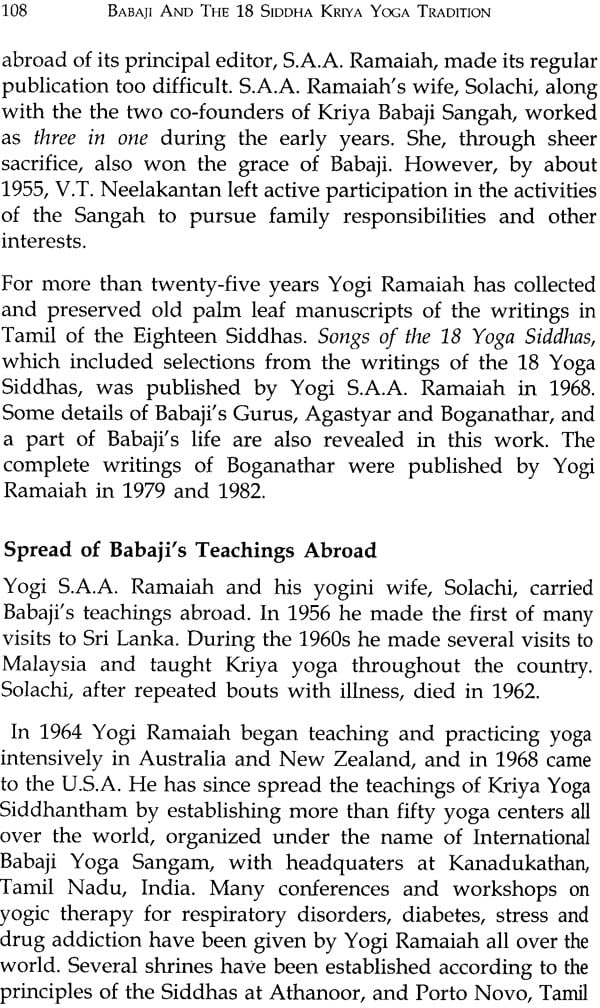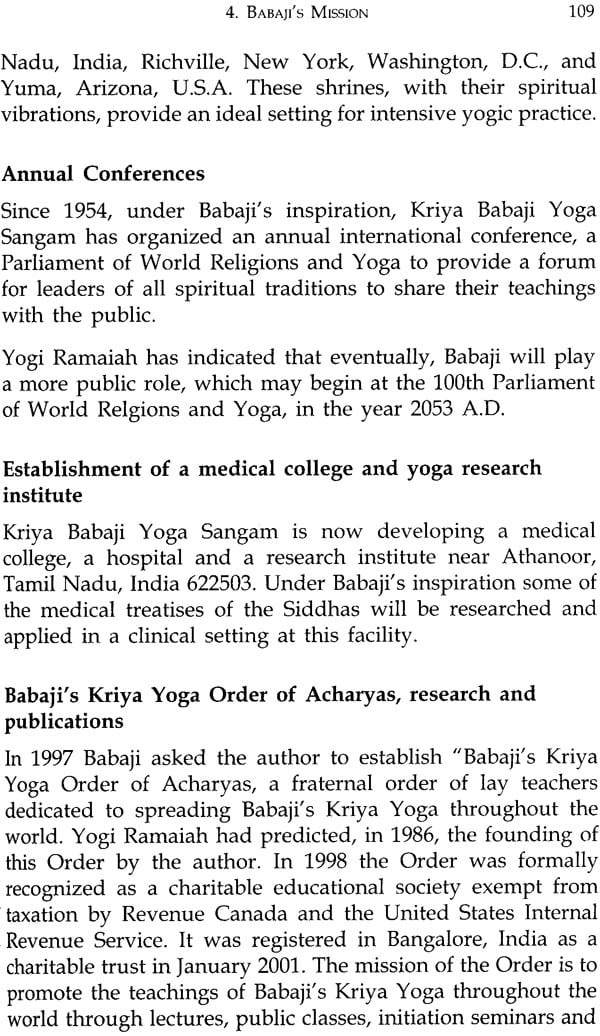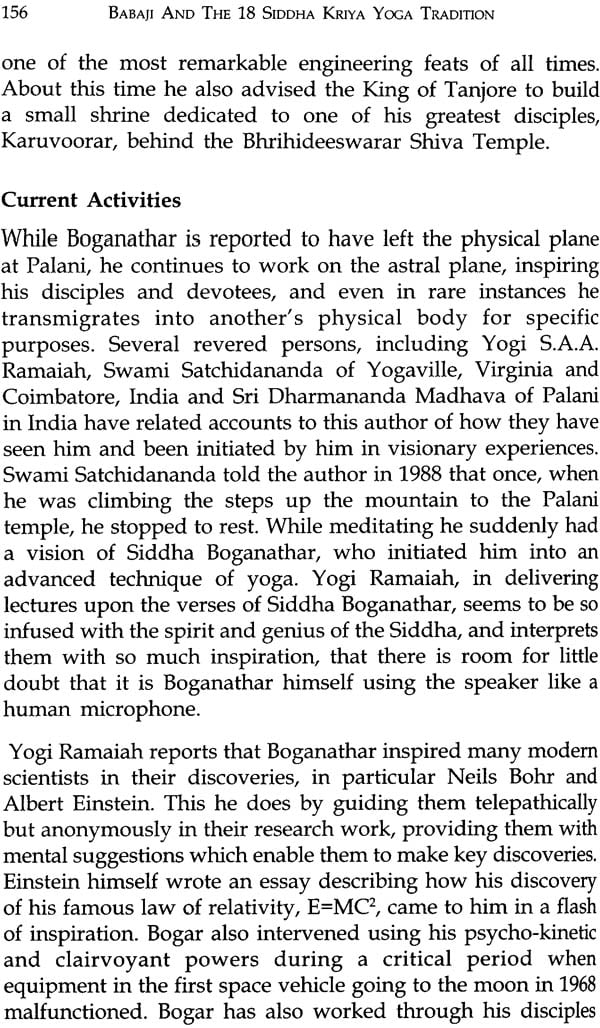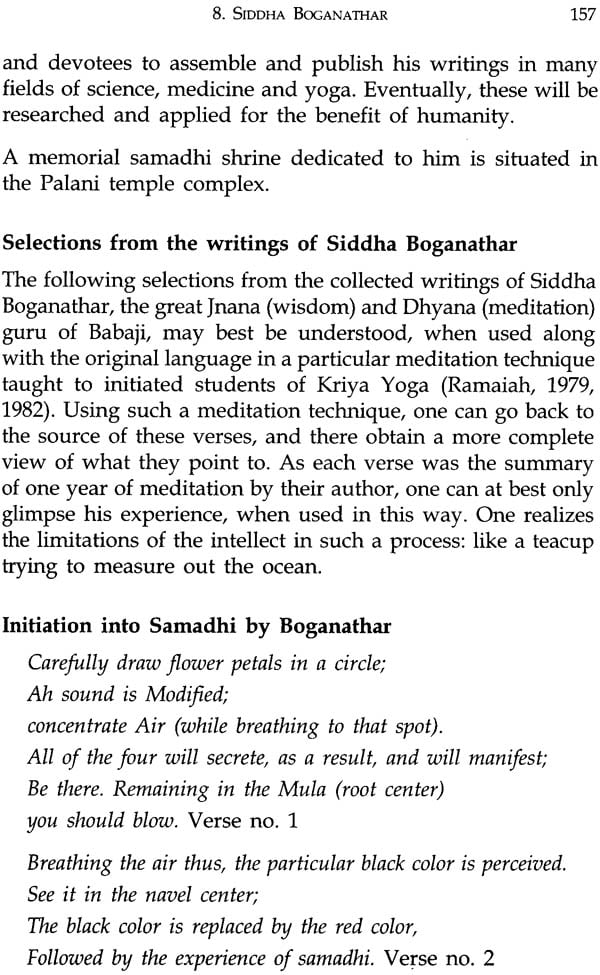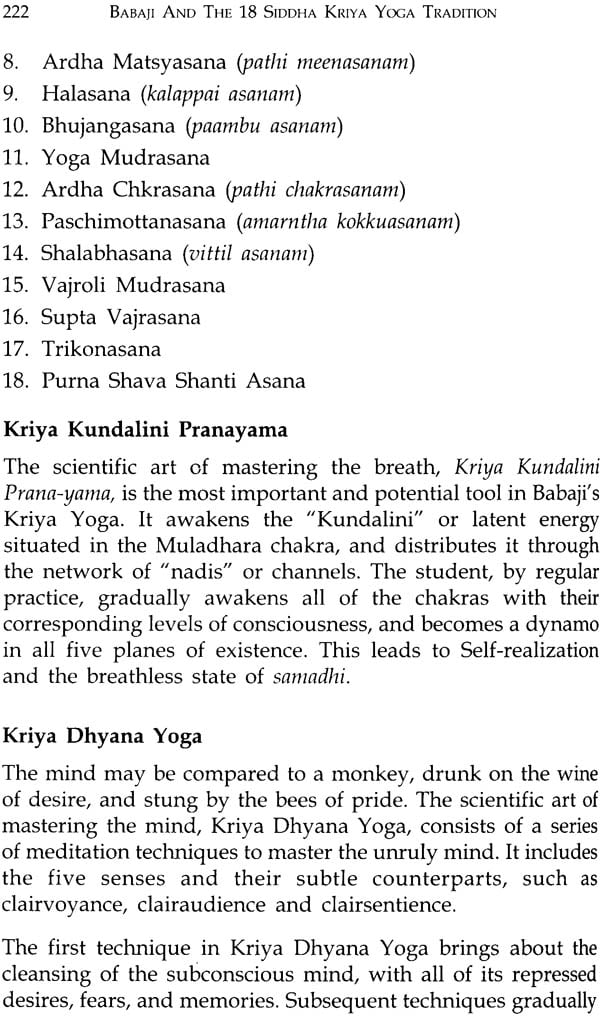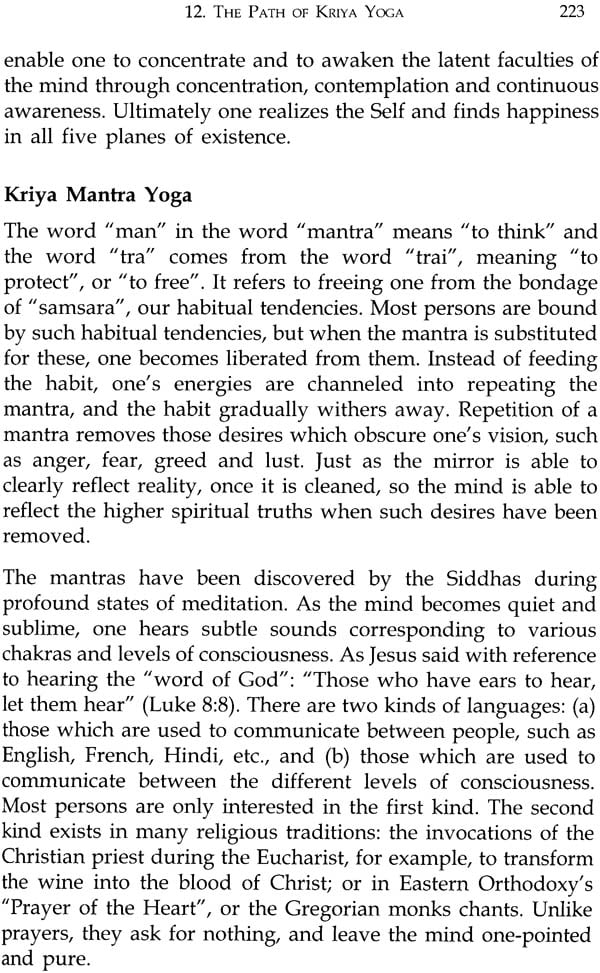
Babaji and the 18 Siddha Kriya Yoga Tradition
Book Specification
| Item Code: | NAD060 |
| Author: | M. Govindan |
| Publisher: | Babaji’s Kriya Yoga Trust |
| Language: | English |
| Edition: | 2004 |
| ISBN: | 1895383005 |
| Pages: | 198 (22 B/W & 4 Color Illustrations) |
| Cover: | Paperback |
| Other Details | 8.5 Inch X 5.5 Inch |
| Weight | 300 gm |
Book Description
This is a rare account of Babaji, who has retained his youthful form since The third century A. D., and of the immortal masters of southern India, The Siddhas, who initiated him into Kriya Yoga, a scientific art for realizing God, truth and self. It relates the inspiring story of Babaji’s birth, childhood, Quest for self-realization, transformation and mission in assisting humanity’s “sacramental evolution”.
The psychophysiology of Kriya Yoga and guidelines for its practice are clearly explained. Kriya Yoga can bring about one’s physical, vital, mental, intellectual And spiritual development, and thus help increase health and happiness.
I wish to express my gratitude to Kriya Babaji Nagraj, who Inspired me to write this book and who guided me at each stage in Its preparation. I am also grateful to Yogi S.A.A. Ramaiah, M.A. (Sc.) M.D. (Hon.), for the many years of training in Kriya Yoga siddhantam And for his tremendous contributions to the collection and preservation of the writings of the 18 Siddhas. I would also like to thank the following:
• Dehbandhau Sikka, Ph.D, for his editorial assistance with the Manuscript and for his many useful suggestions.
• Professor C.E. Nehru, Ph.D, of the City University of New York For his comments regarding the geological history of southern India And the ancient continent of Gondwanaland.
• Professor C. Srinivasan, Ph. D, of Tamil University, Tanjore, Tamil Nadu, India, and E. Ayyappa, CPO, Certified Prosthetics and Orthostist, of Bellflower, California, U.S.A., for reviewing the manuscript, as well as for their suggestions and for writing a foreword and Preface respectively.
• T. R. Thulasiram for the Aurobindo Ashram for his assistance in My research on the connection between Ramalinga, Thrumoolar And Aurobindo.
• My sister, Gail Tarrant, for the beautiful paintings of Banbaji and Mataji, as well as for those of Agastyar, Thirumoolar, Boganathar And Ramalinga.
• The Sri Aurobindo Ashram of Pondicherry for allowing me to Including the photography of Sri Aurobindo.
• Ghansyam Das Gupta of Hardwar, Uttar Pradesh, India, S. Natrajan of Madras, Tamil Nadu, India, Vijay Prakash Lal and Professor Rajinder Kumar Jain of Jawaharlal Nehru University, New Delhi India, who assisted me in my research in Indian during July 1990.
• Johanne Beaudoin for the design and preparation of the book for printing.
• Robert Lajoie, Jean-Pierre Begin, Dr. Vasavan Nair, M.D., and Francis P. Cimachowicz, also of Montreal, for reviewing the Manuscript and offering useful suggestions and encouragement.
This book could not have been completed without the loving Support and encouragement of my wife, Gaetane Annai Desroches The material in this book comes from a variety of sources which has been collected over two decades. Every attempt has been made to acknowledge the sources, where possible.
If the reader finds anything of personal value in this book, please Thank Babaji. Any errors or omissions are my responsibility.
“Babaji and the 18 Siddha Kriya Yoga Tradition” reviews the contributions of the immortal Siddhas and their climatic fountainhead, Kriya Babaji. M. Govindan, has beautifully balanced a lucid scholarship with spiritual insight obtained through many years of Kriya Yoga practice and discipline. It contains soul-stirring words from the ancient and ever present Siddhas (supreme masters of yoga). It is the most accurate and comprehensive exposition of the ancient Kriya Yoga tradition and method published in English to date.
For the reader to become better acquainted with the recent work of Sathguru Kriya Babaji, it seems appropriate to provide a few words of background about the author.
Govindan and myself were both initiated into Kriya Yoga as guru-bai’s” (brother disciples) by a great disciple of Babaji, Yogiar S.A.A. Ramaiah, of Tamil Nadu, India, more than two decades ago. A glimpse into Yogiar’s remarkable relationship with the immortal Himalayan master can be seen within these pages. Yogiar has demonstrated through his life and work a vigorous loyalty to the Siddha tradition which fully justifies the title, “Vivekananda of the south” for those who truly knew him. Yogiar trained Govindan and C his chelas (disciples) with a mixture of love manifested as discipline rarely recorded in spiritual texts. Sri Yukteswar, yogananda’s guru, or Naropa, Milarepa’s guru, may be the most accurate examples which reflect the depth of training received at his ashram. Few could blend with his powerful energy. The ego-centric, ie superficial, and the weak-hearted ran away from his training as quickly as they encountered it. Yogiar could and did create a monumental restructuring in the minds, hearts, and souls of his re1as with a word, a glance, or a mere movement. He understood s students inside and out and uncovered many a “ghost” for them a put to rest. Many teachers can provide the practical techniques for spiritual growth but few have the wisdom and depth to uncover and surgically remove the subtle ego-attachments of their students.
During 1973. Govindan and I lived together in the Kriya Yoga Ashram, Kanadukathan, Tamil Nadu, India, often engaged together in tapas (intensive yogic practices) and mowna yoga (observing inner and outer silence) interrupted twice a day only by the ashram cook. During that era of inner searching we found in each other a reflection of the great master Babaji which has continued to grow brighter with years of sadhana (yogic practices).
Govindan has always been a powerful channel of divine energy, ideas, as well as material and financial support, such as for the construction and development of temples and yoga centers in both India and the West. An enormous, sacred assignment was given to Govindan and myself by Master Babaji and Yogiar Ramaiah to arrange for the construction of a beautiful granite temple at Babaji’s birthplace, in, Porto Novo, India. With the help of Dr. Karan Singh, Yogiar, and especially Babaji, this project was completed successfully. To the extent that Babaji has permitted, scenes from his youth were carved in stone on its roof.
Through subsequent years of teaching and learning during pilgrimages and retreats, and countless “karma yoga” projects (the yoga of selfless service) Govindan and myself enjoyed the confidence of our co-pilgrimage as we steadily turned the soil of life with the Kriya plough and observed our gradual transformation from unsteady sailors into bold helmsmen of the spiritual ship. In 1988, Govindan received the inner call to assist others in their spiritual efforts and to guide them into an awareness of their direct connection with Babaji.
In 1989, I received a similar inner call from Babaji. Practitioners of Babaji’s Kriya Yoga are aware that although the great Kriya master moves mysteriously through the Himalayan region, yet for those who develop the Kriya “keys” he is accessible both within and without, whether in Kathmandu, Nepal or Toledo, Ohio, U.S.A. Philosophers and academics spend lifetimes of hairsplitting mental gymnastics on the meaning of existence but the practicing initiates of Kriya Yoga pierce through the barrier of the thoughts themselves to bask directly in the darshan-light of the great Himalayan Master. The full significance of the Siddhas’ words can only be deciphered by the use of these Kriya “keys” The mantra Siddha, Rama Devar, made a direct challenge to all: “Why have you not surrendered till now! — What Shakti must give is the five satisfactions!”
I am gratified to write a foreword to the fine book of Marshall Govindan of Montreal, Canada, entitled, "Babaji and the 18 Siddha Kriya Yoga Tradition". I met him during 1975 along with Thiru. Yogi S.A.A. Ramaiah who had consecrated him to the holy southern Indian way of life, especially the culture of ancient Saints, Sages and Siddhas. In accepting his request it has become my earnest endeavour to trace the history of the divine doctrine of death-less life by describing some of the numerous references which appear in their writings during ancient, medieval and recent times.
Let me begin by defining a few relevant Tamil words used by the Siddhas. Chittam in Tamil refers to the mind. Siddhi is derived from the same word and refers to the experience of mastery over the mind. Siddhas are those saints who have achieved such mastery, especially by the practice of the Yoga pathway to God.
Thirumoolar
One of the greatest of the 18 Siddhas is Thirumoolar. He has composed 3,000 monumental verses known as Thiru-Mandiram (Sacred Mystic Words). The learned author, M. Govindan has given a very vivid pen-picture of Thirumoolar. Thirumoolar has dealt with almost all the aspects of Saiva (Shiva) religion. The philosophy of deathless life is found in many of his verses and also in his chapter on the eight-fold Asthaanga- Yoga. If one practices these principles of Yoga, the experience of Samadhi, the super-conscious fourth state beyond waking, dreaming and sleeping, is easily possible by His grace. When this experience becomes fully integrated, the state is known as "Siddhi of the physical body" of which there are three kinds. These are:
1. Vuruva Siddhi, siddhi with body, i.e. conversion of corporal body into Effulgence of grace merged with the Bliss of God;
2. Aru - Vuruva Siddhi - Siddhi with and without the body, i.e. conversion of the body into a body of Bliss of God and merged with Him like camphor set on fire, leaving no residue;
3. Aruva Siddhi - Siddhi without the body, i.e. conversion of the body into Effulgence of God and disappearing.
The Siddhas have attained Vuruva Siddhi - Thirumoolar at Chidambaram, Bogar at Palani and ldaik-Kadar at Thiruvannamalai temple - as pointed out by the able author in this book as soruba samadhi - "The physical body glows with the fire of immortality" .
Thirumoolar has sung a special verse on the Sanmaargam (true and perfect pathway to God) in which he brought out the efficacy of the science of deathless life:
"Saarram Sanmaargamaam thatciva - Thaththuvath Thorrangalaana Suruthich Sudar Kandu Ceerram ozhinthu Siva yoga siddharasi - Koorraththai venraar Kurri-p-parinihaar kale".
"Those who after eschewing their anger and visualizing the Effulgence which the Yedaas' described as the fruition of their principles for realizing Shiva and thereby have become Siddhas of Shiva- Yoga (Contemplators of Shiva) and have conquered death, they alone have learnt the secret hint of Sanmaaragam." (Thirumandiram: 1477)
He has also sung, "Those who have attained success in treading the path of not leaving their body dead in this world, have achieved the boon of not being born again in this world", (Thirumandiram: 132)
The significant feature of Thiru-Mandiram is that its author has dealt with Ashtaanga Yoga (eight different "limbs" or phases of Yoga) in great detail. He has not only exposed the secrets of this science embedded therein, but has expressed revolutionary measures to realize its goal. While eulogising the efficacy of Pranayama (breathing practices) he has disclosed:
"That those who are capable of practising them in the proper manner as stipulated will surely dispel death", (Thirumandiram: 571)
Besides, he has postulated the device of conquering death in the following words:
"With His grace one by chanting the name 'Shiva, Shiva', four times should inhale oxygen expanding the abdomen; retain and control the same near the glottis by closing the outlets of the nose, ear and mouth, chanting mentally 'Shiva, Shiva' fourteen times; and then exhale the carbon dioxide through the right hole of the nose chanting 'Shiva, Shiva', 8 times, If one is able to practise in this manner, one not only achieves Siddhi of attaining deathless body but becomes Shiva (God) Himself', (Thirumandiram: 712)
The next phase of this 8 fold Yoga is Prath-Thiyaakaram (unified yoga practice), Thirumoolar has explained this yoga as arousing the extra-ordinary energy manifested as Kundalini Sakthi embedded in the lower abdomen (2 units below the sex organ and 2 units above the anus). This kind of yoga also leads one to ascend bodily and reach God avoiding death. (Thirumandiram: 561)
Boganathar
Boganathar Siddha's works have been collected and edited by Yogi S.A.A. Ramaiah in their original Tamil language in three volumes under the title Bogar Kandam Yoga, in 1979 and 1982. The second volume includes Ashtaanga Yoga. (See the Foreword of the third volume by Dr. C. Srinivasan for its translation into English). This work is not as elaborate as that of Thirumoolar, but it contains all the essential features of this Yoga. The third part of this book is on Siddha medicines. Boganathar has evolved an excellent culture to conquer death. It is a complex medicinal preparation made with herbs and special salt called Muppu. If one is fortunate enough to obtain this and takes it as specified, he or she will never taste death. In one of his verses in the second volume Boganathar taught the preparation of Muppu to his group of 557 disciples who were residing in Siddhar Kaadu (Forest of Siddhas) near Mayilaaduthurai.
Who is Babaji ?
Babaji is a great master of yoga living today in the Himalayas who is sometimes called Kriya Babaji Nagaraj, Mahavatar Babaji or Shiva Baba. His body has not aged since the age of sixteen when he conquered death and attained a supreme state of enlightenment. Adi Shankaracharya (788 AD. - 820 A.D.), in a famous poem describes Babaji, his guru: "Behold, under the banyan tree are seated the aged disciples around their youthful teacher! This is strange indeed! The teacher instructs them only through silence, which in itself is sufficient to solve all their doubts (Sri Ramakrishna Math, 1969, p. 25- 26).
More than sixty-five years ago the Theosophists, the Reverend C.W. Leadbeater and Dr. Annie Besant, also described an extraordinary being who may be none other than Babaji:
"There he stood, 'the Youth of sixteen summers', Sanata Kumara, the 'Eternal- Virgin- Youth', the new ruler of earth, come to his kingdom, his Pupils, the three Kumaras, with him, his Helpers around him; thirty mighty Beings there, great beyond Earth's reckoning, though in graded order, clothed in the glorious bodies they had created by Kriyashakti, the first occult hierarchy, branches of the one spreading Banyan tree, the nursery of future Adepts, the centre of all occult life". (Leadbeater, 1969, p. 299)
During the past forty years, several books, beginning with the Autobiography of a Yogi by Paramahansa Yogananda, written in 1946, have referred to the great spiritual master, Babaji, who for centuries has lived in the Himalayan mountains, appearing occasionally to a fortunate few. Sri Yukteswar, Yogananda's guru, said that Babaji's attainment was so great that it could not even be conceived of (Yogananda, 1969, p.305). Yogananda has stated that Babaji is a "Maha avatara", or great avatara (Yogananda, 1969, p. 305-306). "Avatara" is a Sanskrit word which means "descent" or incarnation of the Godhead in human form. He also characterized "siddhars" as having attained mastery over death. He referred to Agastyar as being an avatar of South India, a miracle worker who has lived from the pre-Christian era right up to the present time, and for whom a considerable Tamil language literature exists (op cit. p. 305-306). Agastya belongs to the "Eighteen Siddha tradition", which is famous among Tamil speaking people of southern India.
Some writers have indicated that Babaji has taken different forms. Baba Hari Dass identified him with Herekhan Baba who appeared in Ranikhet, Uttar Pradesh, India, in the latter part of the 19th century and early part of the 20th century A.D. (Hari Dass, 1975). Leonard Orr (1980 and 1983) identified him with a youth who appeared near Ranikhet in about 1970. He was visited by many Westerners up until his sudden death in 1984. However, in the opinion of this author and Yogi Ramaiah, this Herekhan Baba was not Babaji. Swami Satyeswarananda (1984) has written about his incredible encounters with Babaji. The reader is often left feeling incredulous upon reading of the experiences described in these books. At their best these books have inspired many to take up the practice of yoga. Unfortunately, without understanding the ancient tradition and context from which Babaji brought his Kriya Yoga nor the rigors of the discipline, most seekers have put it aside after some time when their own experiences failed to measure up to those related by such authors.
These authors have not furnished any details regarding the life of Babaji nor about how Babaji attained enlightenment and immortality. More importantly, none of these authors have been able to adequately express the purpose for which Babaji has remained in an immortal state and its relevance for our own lives.
Who are the 18 Siddhas ?
Shiva Puranas are filled with stories which describe how Lord Shiva, (the name for God among a major sect of Hinduism) has sat in meditation on Mt. Kailas, Tibet since time immemorial. He is worshipped by the yogis as Lord, and by all the gods as the supreme Lord. The history of the Siddha tradition begins millions of years ago with the story of Lord Shiva's initiation of his consort or Shakti, Parvati Devi, into Kriya Kundalini Pranayama (the scientific art of mastering the breath) in a huge cave at Amarnath in the Kashmir Himalayas (Ramaiah, 1968, p. 108). Later Yogi Shiva initiated others, including the Siddha Agastyar and the Siddhas Nandi Devar and Thirumoolar on Mount Kailas in Tibet. Agastyar subsequently initiated Babaji.
According to the traditions of southern India there are eighteen siddhas in particular who attained perfection, which included their spiritual, intellectual, mental, vital and physical bodies. The names of these eighteen siddhas vary according to different sources, but it appears most likely that they included the ones listed on following pages (Ramaiah, 1968, p. 2-3; Pillai, 1979, p. 342-349). Besides each is given the name of the place where each of them is reported to have attained the state of perfection, known as "soruba samadhi", their guru, disciples and major contributions. See also Figure 1, "Map of present day India and Sri Lanka" and Figure 2, "Map of Southern India" for locations of the places associated with the 18 Siddhas.
| Acknowledgements | 3 |
| Note on transliteration of Tamil words | |
| Foreword By E. Ayyappa | 9 |
| Introduction | 27 |
| Who is Babaji? Who are the 18 Siddhas? How this book came to be written. The Objectives of this book | |
| Part 1: The Eighteen Siddas and Babaji | 59 |
| Chapter 1. The Eighteen Siddha Tradition History of the 18 Siddha Traditions, the Lost continent of Kumari Kandam. geological Evidence of Gondwana Land. Archaeological Remains of the Indus Valley Civilization. The Tamil Sangams of Literature, Evidence of extensive Communication with distant land. Linguistics. The teachings of Siddyhantham the Sidda’s Yoga and Medicine, Metaphysics and Medicine, Ancient Chemistry, Current training and research in the Siddha System of Medicine. | |
| Chapter 2. The Birth and Childhood of Babaji Nagaraj | 83 |
| Babaji’s birth. A region of great sanctity, the jackfruit incident. Kidnapping and Years of wandering. | |
| Chapter 3. Babaji quest for Self Realization | 89 |
| Pilgrimage to Katirgama, Sri Lanka. The Katairgama temple. Babaji and Boganathar at Katiragam. Quest for initiation from Agastyar at Curtrallam. Soruba Samadhiat Badrinath | |
| Chapter 4. Babaji’s Mission | 99 |
| Adi Shankaracharya, Kabir. Lahiri Sri Yukteswar Giri Maharaj, Paramahanse Yogananda, Yogi S.A.A. Ramaiah and V.T. Neelakanta, First meeting between S.A.A. Ramaiah and V.T. Neelkantan. Organization of Kriya Babaji Sahgah, Activites of Kriya Babaji Sangah. Babaji’s Kriya Yoga Order of Acharyas, research and publications spread of Babaji’s Teachings Abroad. Annual Conferences, Future work. | |
| Chapter 5. Babaji’s Ashram: Gauari Shankar Peetam | 113 |
| Chapter 6. Siddha thirumoolar | 119 |
| Thirumoolar’s mission The Quintessential message of Thirumandiram. Individual responsibility for one’s destiny, Thirumoolar’s Ashtanga yoga Compared to Patanjali’s Yoga Sutras. | |
| Chapter 7 Siddha Agastyar | 133 |
| Agastyar’s Ashrams, Agastyar and the Aryan invasion of southern India. Agastyar and the Tamil language and grammar, Agastyar’s contributions to Science | |
| Chapter 8. Siddha Boganathar | 149 |
| An Oceanic Life Story. A mission to China and transmigration. Transformation of his physical body, Becomes known as Lao-Tzu, founder of Taoism, Return of India. Establishes shrine at Katirgama and attains soruba Samadhi, Second Mission to China, Current activities. Selection from the writings of Siddha Boganathar | |
| Chapter 9. Ramalinga Swamigal | 161 |
| A Sketch of Ramalinga’s life story. The Diving Song of Grace. The Temple of Wisdom. “Into all the bodies of His creation…” The Way of Transformation The Suddha deham or “Perfect Body”. The Pranava Deham or “Body of Grace”. The Gnana Deham or “Body of Bliss”. The Heritage of Ramalings Swamigal. | |
| Part 2: The Scientific art of Kriya Yoga | |
| Chapter 11. The Psychophysiology of Kriya Kundalini Yoga | 197 |
| Breathing and Physiology. The Law of Inverse Proprtions” and longevity. The Storing up of pranic energy. Kriya Yoga. Kriya Health Yoga. Kriya Kundalini Pranayama. The Nadis and the Chakras. Muladhara. Swadhisitanam. Manipuragam. Anahatam. Vishuddi. Ajna. Sahasrara. Kundaklini. The stages of Practice and Awakiening of Kundalini. The Manifestations of the Kundalini Awakening. | |
| Chapter12. The Path of Kriya Yoga | 219 |
| A master key for transforming human society. An Integral Yoga. Kriya Hatha Yoga. Kriya Kundakini Pranayama. Kriya Dhyana Yoga. Mantra Yoga. Kriya Bhakti Yoga. Kriya Karam Yoga. Family Life and Tantra. Getting started In Kriya Hatha Yoga and initiation into the techiniques of Kriya Kundalini Pranayama, dhyana and Mantras. Intergrationg yoga into daily life: the “Anthar Kriya Yoga” experience. Guidelines for the student of Kriya Yoga. Love. RegularKriya Yoga Sadhana. Satsang. Yogic vegetarian diet. Transform sleep into yogic rest. Mental purity, patience, silence and other observations. Seeking inspiration from Babaji and the 18 Siddhas. For more information on training in Babaji’s Kriya Yoga | |
| Bibliography | 239 |
| Glossary | 247 |
